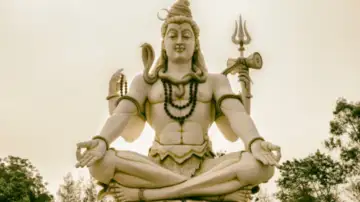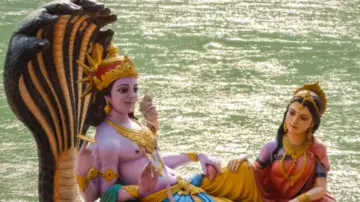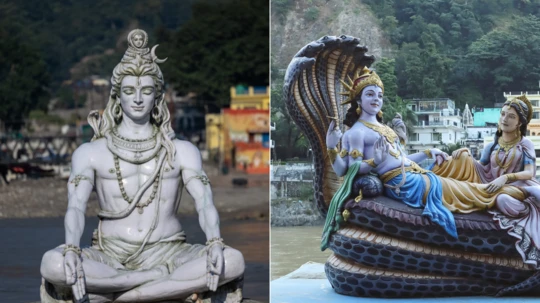In the rich Sanatan Dharma, serpents or Nagas are worshipped beyond Nag Panchami and hold great significance in mythology. The nagas offer divine protection and spiritual awakening among the revered serpents on Earth; two stand out for their extraordinary roles: Vasuki and Sheshnaag.
Vasuki is coiled around Mahadeva’s neck, and on the other hand, Shesha Naga is a multi-headed serpent where Lord Vishnu rests. Their stories reflect why snakes are venerated rather than feared in Hindu tradition.
Vasuki- The serpent coiled around Lord Shiva’s neck
Vasuki, also known as the serpent king, is one of the famous naga or serpents who is wrapped around Lord Shiva’s neck. Born from the sage Kashyapa and Kadru, Vasuki is popularly known for his devotion, wisdom, strength and commitment to Dharma. Unlike other serpents whose power is typically associated with aggression, Vasuki’s story is truly based on surrender and service.
Vasuki is often showcased as the representation of Kundalini Shakti, the coiled spiritual energy that rises from the base of the spine to the crown of consciousness, just as Vasuki rests near the Vishuddha Chakra, the centre of inner truth and expression.

Vasuki’s role was observed widely during Samudra Manthan, or the churning of the cosmic ocean. The devas (gods) and asuras (demons) churned the ocean to obtain amrit, for that they needed a rope which was strong enough to be wrapped around Mount Mandara, which served as the churning rod. Without any hesitation, Vasuki offered himself to become the churning rope, which also allowed to mountain to rotate upon his great body.
The Samudra Manthan not only witnessed strain but cosmic friction and tension of being pulled from both sides. After this act, two profound substances emerged, named Halahala- the deadly poison and Amrit- the divine nectar of immortality. The connection between Lord Shiva and Vasuki deepened.
During the event, Lord Shiva intervened to consume to deadly poison halahala, which threatened to destroy the universe. The poison turned his throat blue, earning him the name Neelkantha. Vasuki’s connection with Shiva deepened through this divine act. As a sign of respect, Shiva wore Vasuki around his neck as a symbol of devotion and power.
The serpent’s placement on Lord Shiva’s neck is symbolic, and it represents that taming the wild energies and finding the correct balance between mind and heart is an important rule of life. In Hindu mythology, Vasuki is also renowned for assisting in other cosmic deeds and being a protector of Dharma.
Shesha Naga- The bed of Lord Vishnu
Shesha Naga, also referred to as Adishesha or Ananta, is the ruler of all serpents and the cosmic supporter. Whether he is 5-headed or 7-headed or even 1000-headed, it is assumed that all the planets in the universe are housed in their heads. It is believed that every time he moves Earth from one head to another, it is alleged that it causes an Earthquake.
Shesha Naga is believed to be the one who is accountable for the notion of gravitational force and makes sure that all planets and stars revolve around each other. Lord Vishnu, the preserver of the universe, is often depicted resting on Shesha Naga in the cosmic ocean of bliss. Shesha Naga is believed to be a worshipper or a bhakt of Lord Vishnu. As per the Mahabharata, serpent Shesha Naga was born to the same parents as Vasuki sage Kashyapa and Kadru.

According to the Puranas, Shesha Naga is said to hold all the planets of the universe on his hoods and consistently sings the praises of Lord Vishnu from all his mouths. As per the Bhagavata Purana, Shesha is known as ‘Sankarshana’ – the tamasic energy of Lord Narayana.
The Naga chose the path of asceticism, meditated deeply to control his mind and gained spiritual enlightenment. Lord Bhrama was pleased by his devotion and granted him a boon. He assigned Shesha to stabilise the Earth by supporting it on his thousand hoods, but from beneath the surface.
Shesha Naga is typically depicted in a majestic form that drifts coiled in space or on the ocean of bliss to create the bed for Lord Vishnu. The serpent is believed to stand for ‘Kundalini Shakti’ because when there is a need, then it can lift its hood and stand vertically.
Kundalini Shakti usually dwells at the Muladhara Chakra (root chakra), which is located at the base of the spine. Once the Kundalini Shakti is activated and travels to the Sahasrara Chakra, then the individual is awakened. The Kundalini Shakti has to be stirred so that it climbs through all seven chief chakras and reaches the Sahasrara Chakra (Crown Chakra), which is housed at the uppermost part of the head.
Both Vasuki and Shesha Naga are powerful serpents in Hindu mythology. Their stories inspire the devotees to rouse the Kundalini Shakti within and also remind us of the sacredness of all forms.
